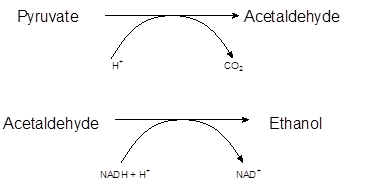
Concept explainers
(a)
Interpretation:
The role of coenzymes NAD+ and NADH in the conversion of pyruvate to acetyl CoA should be determined.
Concept Introduction:
Aerobic respiration occurs in two steps:
- Glycolysis
- Citric acid cycle
Glycolysis is the first step that forms pyruvate as given below:
In the presence of oxygen means aerobic respiration, this pyruvate enters the Krebs cycle and extracts energy in the form of electrons transfer. Electrons are transferred from the pyruvate to the receptors like
Answer to Problem 32P

Explanation of Solution
The
The overall reaction of glycolysis must be written as:
The pyruvate from glycolysis synthesizes acetyl CoA by the loss of one C atom in the form of CO2 gas in the presence of CoenzymeA. This breakdown of pyruvate molecule occurs by transfer of electrons to NAD+ to form NADH. Further, NADH will be used by the cell to produce ATP.

(b)
Interpretation:
The role of coenzymes NAD+ and NADH in the conversion of pyruvate to lactate should be determined.
Concept Introduction:
Aerobic respiration occurs in two steps:
- Glycolysis
- Citric acid cycle
Glycolysis is the first step that forms pyruvate as given below:
In the presence of oxygen means aerobic respiration, this pyruvate enters the Krebs cycle and extracts energy in the form of electrons transfer. Electrons are transferred from the pyruvate to the receptors like
Answer to Problem 32P

Explanation of Solution
The metabolism of glucose starts from the glycolysis process. It is the first step in cellular metabolism to extract energy from glucose. It is the sequence of 10 enzyme-catalyzed reactions that involve the glucose molecules into pyruvate with the production of ATP molecules.
The overall reaction of glycolysis must be written as:
The conversion of pyruvate to lactate is an enzymatical process. It is a hydrogenation reaction in which NADH changes to NAD+whereas the reversible process is catalyzed by lactate dehydrogenases.

(c)
Interpretation:
The role of coenzymes NAD+ and NADH in the conversion of pyruvate to ethanol should be determined.
Concept Introduction:
Aerobic respiration occurs in two steps:
- Glycolysis
- Citric acid cycle
Glycolysis is the first step that forms pyruvate as given below:
In the presence of oxygen means aerobic respiration, this pyruvate enters the Krebs cycle and extracts energy in the form of electrons transfer. Electrons are transferred from the pyruvate to the receptors like
Answer to Problem 32P

Explanation of Solution
The metabolism of glucose starts from the glycolysis process. It is the first step in cellular metabolism to extract energy from glucose. It is the sequence of 10 enzyme-catalyzed reactions which involves the conversion of glucose molecules into pyruvate with production of ATP molecules.
The overall reaction of glycolysis must be written as:
In the anaerobic conditions and presence of yeast, pyruvate converts to carbon dioxide and ethanol. Enzyme pyruvate decarboxylase catalyzes this reaction and removes a carbon dioxide molecule from the pyruvate to yield acetaldehyde which further changes to ethanol in the presence of NADH.

Want to see more full solutions like this?
Chapter 24 Solutions
General, Organic, and Biological Chemistry - 4th edition
- Why are so many different enzymes needed?arrow_forward25. Under anaerobic conditions, yeast produces and alcohol during alcoholic fermentation a. lactate b. CO2 c. glucose d. acetyl CoAarrow_forwardWhich enzyme is involved in the conversion of phosphoenolpyruvate to pyruvate? a. enolase b. ketolase c. pyruvate kinase d. pyruvate oxidasearrow_forward
- 9. An example of an isoenzyme used for clinical diagnosis is a. lactate dehydrogenase b. creatine kinase Oc. lipase d. more than one choice is correctarrow_forwardWhat sugar units will be formed after the hydrolysis sucrose? A. 2 glucose units B. glucose and galactose C. glucose and fructose D. many units of glucosearrow_forwardWhat is the most biochemical reactions inside our body need to speed up?arrow_forward
- 17. In the urea cycle, ions are converted to urea. a. рpyruvate b. sodium C. ammonium O d. glutamatearrow_forward110. The main purpose of glycolysis is to a. oxidize the acetyl group b. make NADH c. make pyruvate d. make protons e. make ATParrow_forward3. ATP + H20 ---> P; + H* + ADP What, if anything, is missing from the equation above? a. "energy" should be added to the product side b. "energy" should be added to the reactant side C. "Coenzyme A" should be added as a catalyst od. the reaction is complete as it isarrow_forward
 Chemistry for Today: General, Organic, and Bioche...ChemistryISBN:9781305960060Author:Spencer L. Seager, Michael R. Slabaugh, Maren S. HansenPublisher:Cengage Learning
Chemistry for Today: General, Organic, and Bioche...ChemistryISBN:9781305960060Author:Spencer L. Seager, Michael R. Slabaugh, Maren S. HansenPublisher:Cengage Learning EBK A SMALL SCALE APPROACH TO ORGANIC LChemistryISBN:9781305446021Author:LampmanPublisher:CENGAGE LEARNING - CONSIGNMENTChemistry: Matter and ChangeChemistryISBN:9780078746376Author:Dinah Zike, Laurel Dingrando, Nicholas Hainen, Cheryl WistromPublisher:Glencoe/McGraw-Hill School Pub Co
EBK A SMALL SCALE APPROACH TO ORGANIC LChemistryISBN:9781305446021Author:LampmanPublisher:CENGAGE LEARNING - CONSIGNMENTChemistry: Matter and ChangeChemistryISBN:9780078746376Author:Dinah Zike, Laurel Dingrando, Nicholas Hainen, Cheryl WistromPublisher:Glencoe/McGraw-Hill School Pub Co Chemistry In FocusChemistryISBN:9781305084476Author:Tro, Nivaldo J., Neu, Don.Publisher:Cengage Learning
Chemistry In FocusChemistryISBN:9781305084476Author:Tro, Nivaldo J., Neu, Don.Publisher:Cengage Learning Chemistry & Chemical ReactivityChemistryISBN:9781337399074Author:John C. Kotz, Paul M. Treichel, John Townsend, David TreichelPublisher:Cengage Learning
Chemistry & Chemical ReactivityChemistryISBN:9781337399074Author:John C. Kotz, Paul M. Treichel, John Townsend, David TreichelPublisher:Cengage Learning Chemistry & Chemical ReactivityChemistryISBN:9781133949640Author:John C. Kotz, Paul M. Treichel, John Townsend, David TreichelPublisher:Cengage Learning
Chemistry & Chemical ReactivityChemistryISBN:9781133949640Author:John C. Kotz, Paul M. Treichel, John Townsend, David TreichelPublisher:Cengage Learning





